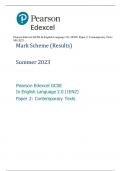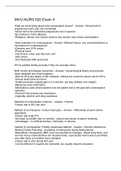Pearson Edexcel GCSE In English Language 2.0 (1EN2) Paper 2: Contemporary Texts
MS 2023
Mark Scheme (Results)
Summer 2023
Pearson Edexcel GCSE
In English Language 2.0 (1EN2)
Paper 2: Contemporary Texts
,Edexcel and BTEC Qualifications
Edexcel and BTEC qualifications are awarded by Pearson, the UK’s largest awarding
body. We provide a wide range of qualifications including academic, vocational,
occupational and specific programmes for employers. For further information visit
our qualifications websites at www.edexcel.com or www.btec.co.uk. Alternatively,
you can get in touch with us using the details on our contact us page at
www.edexcel.com/contactus.
Pearson: helping people progress, everywhere
Pearson aspires to be the world’s leading learning company. Our aim is to help
everyone progress in their lives through education. We believe in every kind of
learning, for all kinds of people, wherever they are in the world. We’ve been involved
in education for over 150 years, and by working across 70 countries, in 100
languages, we have built an international reputation for our commitment to high
standards and raising achievement through innovation in education. Find out more
about how we can help you and your students at: www.pearson.com/uk
Summer 2023
Question Paper Log Number P75200A
Publications code: 1EN2_02_2306_MS
All the material in this publication is copyright
© Pearson Education Ltd 2023
2
, General marking guidance
All candidates must receive the same treatment. Examiners must mark the last
candidate in exactly the same way as they mark the first.
Mark schemes should be applied positively. Candidates must be rewarded
for what they have shown they can do, rather than be penalised for
omissions.
Examiners should mark according to the mark scheme – not according to their
perception of where the grade boundaries may lie.
All the marks on the mark scheme are designed to be awarded. Examiners
should always award full marks if deserved, i.e. if the answer matches the mark
scheme. Examiners should also be prepared to award zero marks if the
candidate’s response is not worthy of credit, according to the mark scheme.
Where some judgement is required, mark schemes will provide the
principles by which marks will be awarded and exemplification/indicative
content will not be exhaustive. However, different examples of responses
will be provided at standardisation.
When examiners are in doubt regarding the application of the mark scheme to a
candidate’s
response, a senior examiner must be consulted before a mark is given.
Crossed-out work should be marked unless the candidate has replaced it with
an alternative response.
Marking guidance for levels-based mark schemes
How to award marks
The indicative content provides examples of how candidates will meet each skill
assessed in the question. The levels descriptors and indicative content reflect the
relative weighting of each skill within each mark level.
Finding the right level
The first stage is to decide which level the answer should be placed in. To do this,
use a ‘best-fit’ approach, deciding which level most closely describes the quality of
the answer. Answers can display characteristics from more than one level, and
where this happens markers must use the guidance below and their professional
judgement to decide which level is most appropriate.
Placing a mark within a level
After a level has been decided on, the next stage is to decide on the mark within the
level. The instructions below tell you how to reward responses within a level.
However, where a level has specific guidance about how to place an answer within
a level, always follow that guidance.
3





